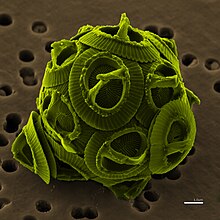Coccolithophore
| Coccolithophore Temporal range: Late Triassic - present |
|
|---|---|
 |
|
| The coccolithophore Gephyrocapsa oceanica | |
| Scientific classification | |
| Domain: | Eukaryota |
| (unranked): | Haptophyta |
| Class: | Prymnesiophyceae |
| Order: | Isochrysidales, Coccolithales |
A coccolithophore (or coccolithophorid, from the adjective ) is a unicellular, eukaryotic phytoplankton (alga). They belong either to the kingdom Protista, according to Robert Whittaker's Five kingdom classification, or Chromalveolata, according to the newer Thomas Cavalier-Smith Biological Classification system. Within the Chromalveolata, the coccolithophorids are in the phylum or division Haptophyta, class Prymnesiophyceae (or Coccolithophyceae). Coccolithophorids are distinguished by special calcium carbonate plates (or scales) of uncertain function called coccoliths, which are also important microfossils. However, there are Prymnesiophyceae species lacking coccoliths (e.g. in genus Prymnesium), so not every member of Prymnesiophyceae is coccolithophorid. Coccolithophores are almost exclusively marine and are found in large numbers throughout the sunlight zone of the ocean.
The most abundant species of coccolithophore, Emiliania huxleyi, belongs to the order Isochrysidales and family Noëlaerhabdaceae. It is found in temperate, subtropical, and tropical oceans. This makes E. huxleyi an important part of the planktonic base of a large proportion of marine food webs. It is also the fastest growing coccolithophore in laboratory cultures. It is studied for the extensive blooms it forms in nutrient depleted waters after the reformation of the summer thermocline. and for its production of molecules known as alkenones that are commonly used by earth scientists as a means to estimate past sea surface temperatures. Coccolithophores are of particular interest to those studying global climate change because as ocean acidity increases, their coccoliths may become even more important as a carbon sink. Furthermore, management strategies are being employed to prevent eutrophication-related coccolithophore blooms, as these blooms lead to a decrease in nutrient flow to lower levels of the ocean.
...
Wikipedia
